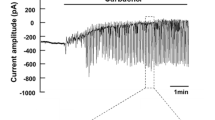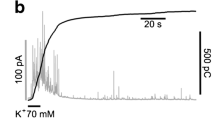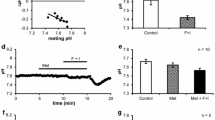Abstract
As in other salivary glands, the secretory cells of the sheep parotid have a resting K+ conductance that is dominated by BK channels, which are activated by acetylcholine (ACh) and are blocked by tetraethylammonium (TEA). Nevertheless, perfusion studies indicate that TEA does not inhibit ACh-evoked fluid secretion or K+ efflux from intact sheep parotid glands. In the present study, we have used whole-cell patch clamp techniques to show that ACh activates K+ and Cl− conductances in sheep parotid secretory cells by increasing intracellular free Ca2+, and we have compared the blocker sensitivity of the ACh-evoked whole-cell K+ current to the previously reported blocker sensitivity of the BK channels seen in these cells.
The ACh-induced whole-cell K+ current was not blocked by TEA (10 mmol/l) or verapamil (100 μmol/l), both of which block the resting K+ conductance and inhibit BK channels in these cells. Quinine (1 mmol/l) and quinidine (1 mmol/l), although only weak blockers of the resting K+ conductance, inhibited the ACh-evoked current at 0 mV (K+ current), by 68% and 78%, respectively. 4-Aminopyridine (10 mmol/l) partially inhibited the ACh-induced K+ current and caused it to fluctuate. It also caused the resting membrane currents to fluctuate, possibly by altering cytosolic free Ca2+. Ba2+ (100 μmol/l), a blocker of the inwardly rectifying K+ conductance in sheep parotid cells, had no effect on the ACh-induced K+ current.
We conclude that the ACh-induced K+ conductance in sheep parotid cells is pharmacologically distinct from both the outwardly rectifying (BK) K+ conductance and the inwardly rectifying K+ conductance seen in unstimulated cells. Given that in vitro perfusion and K+ efflux studies on other salivary glands in which BK channels dominate the resting conductance (e.g., the rat mandibular, rat parotid and mouse mandibular glands) have revealed an insensitivity to TEA, suggesting that BK channels do not carry the ACh-evoked K+ current, we propose that BK channels do not contribute substantially to the K+ current evoked by ACh in the secretory cells of most salivary glands.
Similar content being viewed by others
References
Arita, Y., Kimura, T., Yazu, T., Ogami, Y., Nawata, H. 1991. Effects of calcium-channel blockers on cytosolic free calcium and amylase secretion in rat pancreatic acini. Pharmacol. Toxicol. 68:83–87
Ciechanowicz-Rutkowska, M., Oleksyn, B.J., Suszko-Purzycka, A., Lipinska, T., 1992. Quinidine as a muscarinic antagonist: a structural approach. J. Pharm. Sci. 81:559–564
Cook, D.I., Gard, G.B., Champion, M., Young, J.A. 1988. Patchclamp studies of the electrolyte secretory mechanism of rat mandibular gland cells stimulated with acetylcholine or isoproterenol. In: Molecular Mechanisms in Secretion (25th Alfred Benzon Symposium 1987). N.A. Thorn, M. Treiman, O.H. Petersen, and J.H. Thaysen editors. pp 131–151 Munksgaard, Copenhagen
Cook D.I., Young J.A. 1990. Cation channels and secretion. In: Epithelial Secretion of Water and Electrolytes. J.A. Young and P.Y.D. Wong (eds) pp. 15–38. Springer-Verlag, Heidelberg
Cook, D.I., Wegman, E.A., Ishikawa, T., Poronnik, P., Allen, D.G., Young, J.A. 1992. Tetraethylammonium blocks muscarinically evoked secretion in the sheep parotid gland by a mechanism additional to its blockade of BK channels. Pfluegers Arch. 420:167–171
Dehaye, J.P. 1989. Calcium-activated potassium channels from rat parotid acinar cells. Pfluegers Arch. 414:S158-S159
Evans L.A.R. 1986. Secretory Mechanisms of the Rat Pancreas and Mandibular Gland. PhD Thesis, University of Sydney, Sydney
Evans, L.A.R., Pirani, D.P., Cook, D.I., Young, J.A. 1986. Intraepithelial current flow in rat pancreatic secretory epithelia. Pfluegers Arch. 407 (Suppl. 2):S107-S111
Gallacher, D.V., Morris, A.P. 1986. A patch-clamp study of potassium currents in resting and acetylcholine-stimulated mouse submandibular acinar cells. J. Physiol. 373:379–395
Gallacher, D.V., Morris, A.P. 1987. The receptor-regulated calcium influx in mouse submandibular acinar cells is sodium dependent: a patch-clamp study. J. Physiol. 384:119–130
Gibson, G.E., Manger, T. 1988. Changes in cytosolic free calcium with 1,2,3,4-tetrahydro-5-aminoacridine, 4-aminopyridine and 3,4-diaminopyridine. Biochem. Pharmacol. 37(21):4191–4196
Gray, P.T.A. 1989. The relation of elevation of cytosolic free calcium to activation of membrane conductance in rat parotid acinar cells. Proc. R. Soc. Lond. 237:99–107
Habara, Y., Williams, J.A., Hootman, S.R. 1986. Antimuscarinic effects of chloroquine in rat pancreatic acini. Biochem. Biophys. Res. Comm. 137:664–669
Ishikawa, T., Cook, D.I. 1993. A Ca2+-activated Cl− current in sheep parotid secretory cells. J. Membrane Biol. 135:261–271
Ishikawa, T., Cook, D.I. 1993. Effects of K+ blockers on inwardly and outwardly rectifying whole-cell K+ currents in sheep parotid secretory cells. J. Membrane Biol. 133:29–41
Ishikawa T, Wegman E.A., Cook D.I. 1993. An inwardly rectifying potassium channel in the basolateral membrane of sheep parotid secretory cells. J. Membrane Biol. 131:193–202
Iwatsuki, N., Maruyama, Y., Matsumoto, O., Nishiyama, A. 1985. Activation of Ca2+-dependent Cl− and K+ conductances in rat and mouse parotid acinar cells. Jpn. J. Physiol. 35:933–944
Lee, S.I., Turner, R.J. 1993. Secretagogue induced 86Rb+ efflux from bovine parotid is HCO −3 -dependent. Am. J. Physiol. 264:R162–R168
Martin, A.C., Shuttleworth, T.J. 1994. Muscarinic receptor activation stimulates oscillations in K+ and Cl− currents which are acutely dependent on extracellular Ca2+ in avian salt glands. Pfluegers Arch. 426:231–238
Marty, A., Evans, M.G., Tan, Y.P., Trautmann, A. 1986. Muscarinic response in rat lacrimal glands. J. Exp. Biol. 124:15–32
Maruyama, Y., Gallacher, D.V., Petersen, O.H. 1983. Voltage and Ca2+-activated K+ channel in basolateral acinar cell membranes in mammalian salivary glands. Nature 302:827–829
Maruyama, Y., Nishiyama, A., Izumi, T., Hoshimiya, N., Petersen, O.H. 1986. Ensemble noise and current relaxation analysis of K+ current in single isolated salivary acinar cells from rat. Pfluegers Arch. 406:69–72
McArthur, K.E., Jensen, R.T., Gardner, J.D. 1983. The actions of tetraethylammonium on dispersed acini from guinea pig pancreas. Biochim. Biophys. Acta 762:373–377
McMillian, M.K., Soltoff, S.P., Lechleiter, J.D., Cantley, L.C., Talamo, B.R. 1988. Extracellular ATP increases free cytosolic calcium in rat parotid acinar cells. Differences from phospholipase C-linked receptor agonists. Biochem. J. 255:291–300
Morris, A.P., Gallacher, D.V., Fuller, C.M., Scott, J. 1987. Cholinergic receptor-regulation of potassium channels and potassium transport in human submandibular acinar cells. J. Dent. Res. 66:541–546
Petersen, O.H. 1992. Stimulus-secretion coupling: cytoplasmic calcium signals and the control of ion channels in exocrine acinar cells. J. Physiol. 448:1–51
Petersen, O.H., Maruyama, Y. 1984. Calcium-activated potassium channels and their role in secretion. Nature 307:693–696
Richards, N.W., Lowy, R.J., Ernst, S.A., Dawson, D.C. 1989. Two K+ channel types, muscarinic agonist-activated and inwardly rectifying, in a Cl− secretory epithelium: the avian salt gland. J. Gen. Physiol. 93:1171–1194
Rogawski, M.A. 1989. Aminopyridines enhance opening of calcium-activated potassium channels in GH3 anterior pituitary cells. Mol. Pharmacol. 35(4):458–468
Shigetomi, T., Hayashi, T., Ueda, M., Kaneda, T., Tokuno, H., Takai, A., Tomita, T. 1991. Effects of Ca2+ removal and of tetraethylammonium on membrane currents induced by carbachol in isolated cells from the rat parotid gland. Pfluegers Arch. 419:332–337
Smith, P.M., Gallacher, D.V. 1992. Acetylcholine and caffeine evoked repetitive transient Ca2+ activated K+ and Cl− currents in mouse submandibular cells. J. Physiol. 449:109–120
Soltoff, S.P., McMillian, M.K., Cantley, L.C., Cragoe, E.J., Talamo, B.R. 1989. Effects of muscarinic, alpha-adrenergic, and substance-P agonists and ionomycin on ion transport mechanisms in rat parotid acinar cell. The dependence of ion transport on intracellular calcium. J. Gen. Physiol. 93:285–319
Stahl, F., Lepple-Wienhues, A., Kuppinger, M., Schneider, U., Wiederholt, M. 1991. Measurements of intracellular calcium and contractility in human ciliary muscle. Pfluegers Arch. 418:531–537
Suzuki, K., Petersen, C.C.H., Petersen, O.H. 1985. Hormonal activation of single K+ channels via internal messenger in isolated pancreatic acinar cells. FEBS Lett. 192:306–312
Trautmann, A., Marty, A. 1984. Activation of Ca-dependent K channels by carbamylcholine in rat lacrimal glands. Proc. Natl. Acad. Sci. USA 81:611–615
Wegman, E.A., Ishikawa, T., Young, J.A., Cook, D.I. 1992. Cation channels in the basolateral membrane of sheep parotid secretory cells. Am. J. Physiol. 263:G786-G794
Wright, R.D., Blair-West, J.R. 1990. The effects of K+ channel blockers on ovine parotid secretion depend on the mode of stimulation. Exp. Physiol. 75:339–348
Author information
Authors and Affiliations
Additional information
This project was supported by the Australian Research Council. We thank Dr. N. Sangster, Dr. J. Rothwell and Mr. R. Murphy for giving us access to their sheep.
Rights and permissions
About this article
Cite this article
Hayashi, T., Hirono, C., Young, J.A. et al. The ACh-induced whole-cell currents in sheep parotid secretory cells. Do BK channels really carry the ACh-evoked whole-cell K+ current?. J. Membarin Biol. 144, 157–166 (1995). https://doi.org/10.1007/BF00232801
Revised:
Issue Date:
DOI: https://doi.org/10.1007/BF00232801




